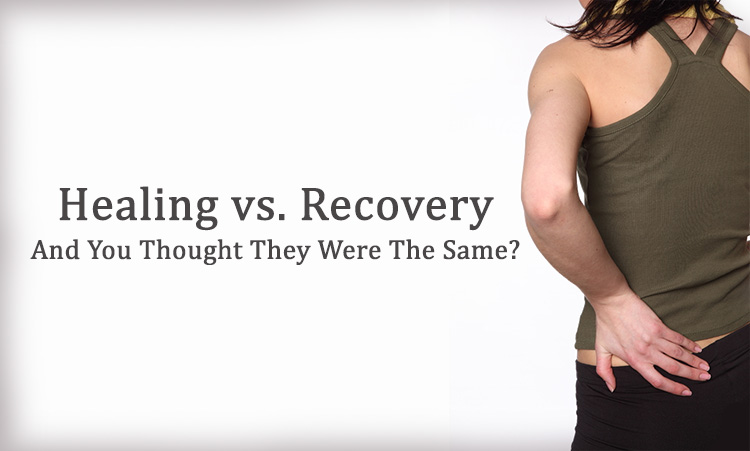“My injury happened 6 months ago, but I still can’t lift heavy weights”
“My wound healed, but it still hurts”
Sounds familiar?
Injuries are fairly common in gyms. A strain here and there, a minor muscle rupture and other minor injuries affects everyone almost once a year.
“Healing of an injury” and “Recovery from an injury” are two phrases people often use interchangeably. To clear out any confusion about injury and the related pain, it is important to understand that healing and recovery are two closely related but, easily distinguishable terms.
How and why are the different?
Why is it even important to understand the distinction?
Throughout this article you would get answers to many of your questions related to injury, pain and rehabilitation. By the end of the article, you would come out as an expert on this topic.
Contents
Healing vs. Recovery
I will try to keep things simple here.
Healing: It is our body’s natural process of repairing any damages or fighting with a disease. For a clear understanding, healing process is complete when the ruptured tissue has healed or when the body is free from the infection.
Recovery: In medical terms, recovery is defined as a return to the pre-morbid state. This essentially means that you have started to feel better and can do what you did before. Some healing may be a part of recovery while the remainder may happen after the recovery.
At the end of the day, all we want is recovery so that the feeling of discomfort subsides. Fortunately, it is possible to speed up both healing and recovery. I will get to it later.
Both the processes occur together and are linked to each other.
For example, in some cases full recovery cannot happen without complete healing because the pain would remain till the wound has healed. But there is some difference and now you know what that is.
Give me an opportunity to explain this. I will take two examples in order to make it crystal clear.
Full Recovery, but incomplete healing
There is a possibility that an injury never heals completely, but you return to the pre-morbid state and start performing the regular functions.
For a simple example, you had a sprain in your ankle, the injury never fully healed because the tissue repair wasn’t complete. You did not take proper rehab, because of which the muscle repair did not go as the doctors planned. But, the ankle has become as strong as it was before the sprain, you can easily walk and dance.
What has happened is that your body has adapted to the change and you can do the normal functions regularly. In other words, you have ‘recovered’ because you can do everything that you did before the sprain, but you haven’t ‘healed’ thoroughly.
Full Healing, but incomplete Recovery
Vice versa to the above case, your injury may heal, but you may not fully recover. For example, you may have seen many sportspersons had to end their career because of an injury that they could never recover from. Injuries heal through normal or medical course, but recovery from an injury requires much more than that.
This may happen because of a number of reasons like loss of an ability, deconditioning or fear of reinjury.[1] One of the best wicket keepers in the history of cricket, South African Mark Boucher had to take premature retirement from the sport because of an eye injury. The injury healed, there was no pain or discomfort, but the recovery was never complete because of the partial loss of visibility.
The natural process of healing was complete, but he could never return to the pre-morbid state, which was playing cricket that required normal eyesight.
Both these cases show how important full recovery and complete healing are in order to lead a healthy life post injury
Your Focus?
It is important that you give your injury an optimal healing and recovery environment. You should follow the regular progression of injury recovery also known as the PRICEM model.
You would have heard of the PRICE model, the M was added recently to add another constituent in the model. The model can be broken down into the following constituents:
- P for Protection: Protect your injury with a brace or a taping. This would restrict the area from movement and also call out to your fellows that you are injured and they have to act with caution.
- R for Rest: Never ever use the injured body part, no matter how small the injury is. Any voluntary activity may possibly disrupt proper healing and as a result recovery.
- I for Ice: Ice packs on the injured area can help reduce inflammation by slowing down the blood flow. The importance of ice treatment increases if it is a muscle injury.
- C for Compression: Compression of the injured area may prevent the area from swelling
- E for Elevation: elevation of the injured area reduces the blood flow in the area. This keeps the inflammation out of the injured area.
- M for Movement: Various studies show that early movement can speed up the process of both healing and recovery. [2]
This and proper medication is all you can do to optimized healing. For optimized recovery as well, these things are very important, but there are certain other things that you would have to take care of. For example you have to take proper rehab, develop the right mindset so that the fear in your mind does not block recovery and other such things.
In the end, we should strive for both “Complete Healing” and “Complete Recovery”.
“Happy Healing!”
Or should I say “Happy Recovery”??
Also read: Why is Nutrition necessary for injury recovery?
References [1]Fear of movement/(re)injury predicting chronic disabling low back pain: a prospective inception cohort study. Swinkels-Meewisse IE1, Roelofs J, Schouten EG, Verbeek AL, Oostendorp RA, Vlaeyen JW. http://www.ncbi.nlm.nih.gov/pubmed/16540870.^Back to Top^ [2]Effects of constraint-induced movement therapy on neurogenesis and functional recovery after early hypoxic-ischemic injury in mice. Rha DW1, Kang SW, Park YG, Cho SR, Lee WT, Lee JE, Nam CM, Han KH, Park ES. http://www.ncbi.nlm.nih.gov/pubmed/21232055. ^Back to Top^







Comments are off this post!